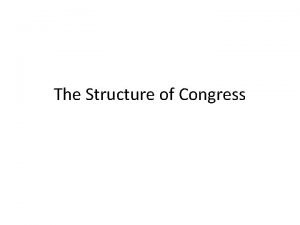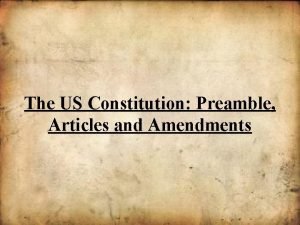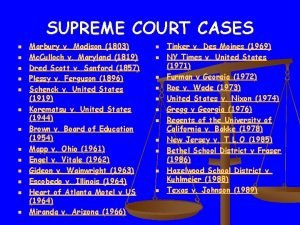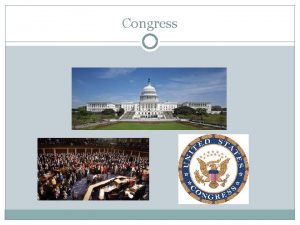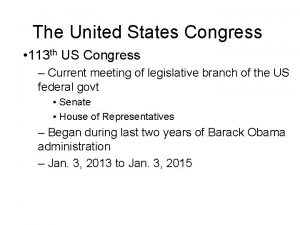Congress Introduction The Framers of the United States


















- Slides: 18

Congress

Introduction • The Framers of the United States Constitution created a bicameral Congress consisting of a House of Representatives and a Senate. • The two houses of Congress have different characters.

Reasons Why the Framers Created A Bicameral Legislature • Drawing on historical experience – The Framers were intimately familiar with the British system of government. – The British system features a bicameral system with a House of Lords and a House of Commons. – Most of the colonial legislatures and state legislatures were bicameral.

Fulfilling the Connecticut Compromise • Led by Virginia, the large states wanted a bicameral legislature based on population. • Led by New Jersey, the small sates wanted a unicameral Congress with equal representation for each state. • The Framers resolved the dispute by agreeing to a compromise calling for a bicameral Congress with representation in a House of Representatives based on population and a Senate in which the States would have equal representation.

Implementing Federalism • A bicameral legislature provided for two types of representation. • The House represented the interests of the people, while the Senate represented the interests of the states. • A bicameral legislature fragmented power, thus checking majority interests while protecting minority interests. • A bicameral legislature slowed the legislative process, thus encouraging careful deliberation and compromise.

Differences Between The House and the Senate • House of Representatives – 435 members – Two-year terms – A representative must be at least 25 years old, an American citizen for 7 years, and a resident of the state from which he or she is elected

Differences Between The House and the Senate • Senate – 100 members – Six-year terms – A senator must be at least 30 years old, an American citizen for 9 years, and a resident of the state from which he or she is elected.

Differences Between The House and the Senate • Election – Members of the House of Representatives have always been elected by eligible voters. – When the Constitution was ratified, the House of Representatives was the new government’s only body directly elected by the people. – Senators were originally chosen by state legislatures. – The 27 th Amendment (1913) mandated that Senators be elected by voters in each state.

Differences Between The House and the Senate • Special Powers – House of Representatives • Initiates revenue bills • Brings changes of impeachment against the president, vice president, and all civil officers of the United States • Chooses the president when the electoral college is deadlocked

Differences Between The House and the Senate • Special Powers – Senate • Ratifies treaties negotiated by the President • Possesses the sole power to try or judge impeachment cases. • Confirms judicial appointments, including United States attorneys, federal judges, and United States Supreme Court Judges • Confirms executive appointment, including cabinet heads, the director of the FBI, and the U. S. attorney general

The House of Representatives • Size and Apportionment – The Constitution does not set the exact size of the House of Representatives. – It does stipulate that its size shall be apportioned or distributed among the states based on their respective populations. – The Constitution guarantees that each state will have at least one representative, regardless of its population. – Seven states currently have one seat in the House of Representatives (Alaska, Delaware, Montana, North Dakota, South Dakota, Vermont, and Wyoming).

House of Representatives • Reapportionment – The Constitution directs Congress to reapportion (reallocate) House seats after a census taken at ten -year intervals. – As the population of the U. S. increased, so did the number of representatives in the House. – By 1929, the House had grown to 435 seats. – The Reapportionment act of 1929 set the permanent size of the House at 435 members. – As a result, each seat now represents an average of 700, 000 people.

House of Representatives • Reapportionment – Reapportionment is important because it increases or decreases both the number of seats a stat has in the House of Representatives and the number of electoral votes a state has in the electoral college. – As a state’s representation increases, so does its potential influence. – Conversely, as a state’s representation decreases, so does its potential influence.

House of Representatives • Districts – The Constitution does not define or discuss congressional districts. – In 1842, Congress stipulated that all seats in the House of Representatives would be filled from single-member districts. – The 1842 law assigned each state legislature the responsibility of drawing the boundary lines of its congressional districts.

House of Representatives • Gerrymandering – Gerrymandering is the legislative process by which the majority party in each state legislature redraws congressional districts to ensure the maximum number of seats for its candidates. – Gerrymandering has the following consequences: • It protects incumbents and discourages challengers. • It strengthens the majority party while weakening the opposition party. • It increases or decreases minority representation.

The House of Representatives • Supreme Court Limitations on Congressional Redistricting: – Because rural areas dominated many state legislatures, congressional districts often favored less-populous rural areas of a state. – Westberry v. Sanders (1964) set forth the principle of “one person, one vote” in drawing congressional districts.

The House of Representatives – The case triggered widespread redistricting that gave cities and suburbs greater representation in Congress. – Supreme courts decisions have placed the following limitations on congressional redistricting: • • • Districts must be equally populated. Districts must be compact. Lines must be contiguous or connected. Redistricting cannot dilute minority voting strength. District lines cannot be drawn based solely on race. However, race can be one of a variety of factors that are considered.

The House of Representatives • It is important to note that Supreme Court decisions have not eliminated gerrymandering for partisan political purposes.
 What are the two houses of the united states congress?
What are the two houses of the united states congress? Why did the framers create a bicameral legislature
Why did the framers create a bicameral legislature Framers wanted
Framers wanted How does the constitution guard against tyranny?
How does the constitution guard against tyranny? Was the united states on the axis powers or allied powers?
Was the united states on the axis powers or allied powers? Many _____ people have settled in this megalopolis.
Many _____ people have settled in this megalopolis. Sectionalism map of the united states
Sectionalism map of the united states Soccer league hierarchy
Soccer league hierarchy United states v nixon outcome
United states v nixon outcome United states student association
United states student association The united states ought to provide a universal basic income
The united states ought to provide a universal basic income Preamble of the constitution
Preamble of the constitution The united states in the caribbean 1776 to 1985
The united states in the caribbean 1776 to 1985 Products of the southeast
Products of the southeast Expansion of the united states of america 1607 to 1853 map
Expansion of the united states of america 1607 to 1853 map Why did truman believe greece needed american aid in 1947
Why did truman believe greece needed american aid in 1947 Spanish cession previous owner
Spanish cession previous owner Who wrote awake united states
Who wrote awake united states Mapp v ohio
Mapp v ohio
